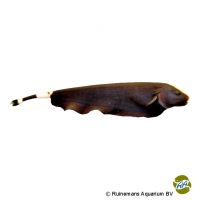Black Ghost Knifefish (Apteronotus albifrons)
| Black Ghost Knifefish Apteronotus albifrons | |
|---|---|
| Name | Black Ghost Knifefish |
| Name Lat. | Apteronotus albifrons |
| Synonym | Gymnotus albifrons |
| Family | Ghost Knifefishes |
| Family lat. | Apteronotidae |
| Order | Knifefishes |
| Order lat. | Gymnotiformes |
| Origin | South America |
| Habitat | Rivers |
| Diet | Carnivore |
| pH | 6.5-7.0 |
| Behavior | Semi-aggressive |
| Keeping | Individual, harem |
| Care Level | Difficult |
| Reproduction | Egg scatterer |
| Breeding | Difficult |
| Life Span | 8-10 years |
| Protection | No |
| Metric Units | |
| Size | 40 cm |
| Temperature | 20-28 °C |
| Hardness | < 10 °dH |
| Aquarium | 500 l |
| US Units | |
| Size | 16" |
| Temperature | 68-82 °F |
| Hardness | < 178 ppm |
| Aquarium | 150 gal |
Distribution and habitat
White-fronted knifefish are widespread in the north of South America, from Peru through Ecuador, Colombia, Venezuela and Brazil to Guyana. There they live mostly in flowing waters, where they often stay hidden in the dense underwater vegetation during the day.
Maintenance
The aquarium should have a dense border planting, with numerous hiding places (roots, stones, caves) and provide sufficient swimming space. A dark substrate of fine sand or gravel covered with some foliage (e.g. sea almond tree, oak leaves), soft water, a weak current and subdued light (floating plant cover) is ideal.
No ammonia, ammonium and nitrite should be detectable, the nitrate value should not exceed 100 mg/l. To ensure the water quality and oxygen content, a filter and heater adapted to the aquarium size is required, as well as lighting for the species-appropriate day-night rhythm of the animals.
Diet
The food supply consists of artemia, mysis, mosquito larvae, snails, mussel, crab and fish meat, which is also accepted frozen, or a commercial frozen food mixture supplemented with live earthworms, fly maggots, etc., according to their size. Dry food (flakes, pellets, granules) is occasionally accepted, but should not be the main diet.
Only as much should be fed as is eaten immediately (in a maximum of 10 minutes). Regular and varied feeding promotes health and avoids deficiency symptoms
Behaviour and compatibility
It is recommended to keep them singly or in a harem (one male with several females). Keeping several animals is only possible in a much larger, richly structured tank. They can be well socialized with large, peaceful and robust South American cichlids, such as angelfish, Cichla and Geophagus species, as well as large South American tetras and catfish. Fish that are too small are considered prey.
Basically, only mutually compatible fish species with similar water condition and water temperature requirements should be socialized.
Sex dimorphism
There are no known external distinguishing characteristics.
Reproduction and breeding
Breeding in the aquarium has already succeeded several times. The eggs, up to 300 pieces, are laid in a cave or between stones. The larvae hatch after about 3 days and have used up their yolk sac after about a week. To protect the fry, they should be separated, as the parents are spawn predators
Fry must be fed several times a day with special rearing food (e.g. Artemia nauplii). In a community tank breeding is hardly possible, because the spawn is easy prey.
Important
With their long anal fin reaching to the head, they can swim forward as well as backward by undulating movement. When swimming backwards, the filamentous tail serves as a tactile organ.
They have an electrical organ with which they constantly send electrical signals to orient themselves and locate prey
Sharp-edged or rough furnishings (e.g. lava stones) should be avoided, as they can cause skin injuries and thus infections
The well-being of the fish should be monitored regularly. Temperature should be checked daily, pH, hardness and nitrate value at least every 14 days. Regular partial water changes are recommended, even if the contaminant level has not yet reached the upper limit. Sudden changes in water quality should be avoided. Newly introduced fish must be accustomed slowly to the water in the aquarium.
Further literature can be found in your pet store.
References
Text: Werner Winter; Image: Ruinemans Aquarium B.V.
Source: BMELV (1998): Tierschutzgutachten - Haltung von Zierfischen (Süßwasser); RIEHL & BAENSCH (2006): Aquarien Atlas Bd. 1, Mergus Verlag; ENGELMANN (2005): Zootierhaltung - Tiere in menschlicher Obhut: Fische, Verlag Harri Deutsch
- Gemäß § 21 Abs. 5 Tierschutzgesetz idgF
